[English] 日本語
 Yorodumi
Yorodumi- EMDB-49223: Viral protein DP71L in complex with phosphorylated eIF2alpha (NTD... -
+ Open data
Open data
- Basic information
Basic information
| Entry |  | |||||||||
|---|---|---|---|---|---|---|---|---|---|---|
| Title | Viral protein DP71L in complex with phosphorylated eIF2alpha (NTD) and protein phosphatase 1A (D64A), stabilized by G-actin/DNAseI | |||||||||
 Map data Map data | ||||||||||
 Sample Sample |
| |||||||||
 Keywords Keywords | Phosphatase / complex / ISR / TRANSLATION | |||||||||
| Function / homology |  Function and homology information Function and homology informationregulation of neutrophil mediated cytotoxicity / zymogen granule / regulation of macromolecule metabolic process / regulation of primary metabolic process / regulation of acute inflammatory response / regulation of glycogen catabolic process / protein serine/threonine phosphatase inhibitor activity / positive regulation of termination of RNA polymerase II transcription, poly(A)-coupled / translation initiation ternary complex / regulation of translation in response to endoplasmic reticulum stress ...regulation of neutrophil mediated cytotoxicity / zymogen granule / regulation of macromolecule metabolic process / regulation of primary metabolic process / regulation of acute inflammatory response / regulation of glycogen catabolic process / protein serine/threonine phosphatase inhibitor activity / positive regulation of termination of RNA polymerase II transcription, poly(A)-coupled / translation initiation ternary complex / regulation of translation in response to endoplasmic reticulum stress / glial limiting end-foot / HRI-mediated signaling / deoxyribonuclease I / response to manganese-induced endoplasmic reticulum stress / PTW/PP1 phosphatase complex / Cellular response to mitochondrial stress / positive regulation of type B pancreatic cell apoptotic process / Response of EIF2AK1 (HRI) to heme deficiency / Recycling of eIF2:GDP / negative regulation of translational initiation in response to stress / protein phosphatase type 1 complex / PERK-mediated unfolded protein response / PERK regulates gene expression / glycogen granule / RNA polymerase II promoter clearance / RNA polymerase II CTD heptapeptide repeat S5 phosphatase activity / response to kainic acid / deoxyribonuclease I activity / eukaryotic translation initiation factor 2 complex / symbiont-mediated suppression of host translation initiation / neutrophil activation involved in immune response / cadherin binding involved in cell-cell adhesion / protein phosphatase 1 binding / regulation of translational initiation in response to stress / eukaryotic 48S preinitiation complex / positive regulation of extrinsic apoptotic signaling pathway in absence of ligand / DNA catabolic process / dephosphorylation / regulation of canonical Wnt signaling pathway / Formation of the ternary complex, and subsequently, the 43S complex / cytoskeletal motor activator activity / glycogen metabolic process / Ribosomal scanning and start codon recognition / myosin heavy chain binding / protein-serine/threonine phosphatase / branching morphogenesis of an epithelial tube / entrainment of circadian clock by photoperiod / Translation initiation complex formation / Triglyceride catabolism / tropomyosin binding / actin filament bundle / Maturation of hRSV A proteins / troponin I binding / filamentous actin / mesenchyme migration / protein serine/threonine phosphatase activity / phosphatase activity / telomere maintenance in response to DNA damage / phosphoprotein phosphatase activity / skeletal muscle myofibril / actin filament bundle assembly / striated muscle thin filament / negative regulation of transcription elongation by RNA polymerase II / skeletal muscle thin filament assembly / actin monomer binding / transition metal ion binding / Response of EIF2AK4 (GCN2) to amino acid deficiency / DARPP-32 events / GTP hydrolysis and joining of the 60S ribosomal subunit / positive regulation of glycogen biosynthetic process / L13a-mediated translational silencing of Ceruloplasmin expression / ribonucleoprotein complex binding / protein dephosphorylation / mitophagy / skeletal muscle fiber development / stress fiber / titin binding / actin filament polymerization / translation initiation factor activity / stress granule assembly / lung development / cellular response to amino acid starvation / response to endoplasmic reticulum stress / Downregulation of TGF-beta receptor signaling / actin filament / adherens junction / filopodium / translational initiation / circadian regulation of gene expression / positive regulation of transcription elongation by RNA polymerase II / regulation of circadian rhythm / PKR-mediated signaling / ABC-family proteins mediated transport / response to lead ion / Hydrolases; Acting on acid anhydrides; Acting on acid anhydrides to facilitate cellular and subcellular movement / cytoplasmic stress granule / calcium-dependent protein binding / cellular response to UV / : / nuclear envelope Similarity search - Function | |||||||||
| Biological species |  Homo sapiens (human) / Homo sapiens (human) /   African swine fever virus / African swine fever virus /   | |||||||||
| Method | single particle reconstruction / cryo EM / Resolution: 3.03 Å | |||||||||
 Authors Authors | Reineke LC / Dalwadi U / Croll T / Arthur C / Lee DJ / Frost A / Costa-Mattioli M | |||||||||
| Funding support | 1 items
| |||||||||
 Citation Citation |  Journal: bioRxiv / Year: 2025 Journal: bioRxiv / Year: 2025Title: Harnessing the Evolution of Proteostasis Networks to Reverse Cognitive Dysfunction. Abstract: The integrated stress response (ISR) is a highly conserved network essential for maintaining cellular homeostasis and cognitive function. Here, we investigated how persistent ISR activation impacts ...The integrated stress response (ISR) is a highly conserved network essential for maintaining cellular homeostasis and cognitive function. Here, we investigated how persistent ISR activation impacts cognitive performance, primarily focusing on a PPP1R15B genetic variant associated with intellectual disability. By generating a novel mouse model that mimics this human condition, we revealed that this variant destabilizes the PPP1R15B•PP1 phosphatase complex, resulting in chronic ISR activation, impaired protein synthesis, and deficits in long-term memory. Importantly, we found that the cognitive and synaptic deficits in mice are directly due to ISR activation. Leveraging insights from evolutionary biology, we characterized DP71L, a viral orthologue of PPP1R15B, through detailed molecular and structural analyses, uncovering its mechanism of action as a potent pan-ISR inhibitor. Remarkably, we found that DP71L not only buffers cognitive decline associated with a wide array of conditions-including Down syndrome, Alzheimer's disease and aging-but also enhances long-term synaptic plasticity and memory in healthy mice. These findings highlight the promise of utilizing evolutionary insight to inform innovative therapeutic strategies. | |||||||||
| History |
|
- Structure visualization
Structure visualization
| Supplemental images |
|---|
- Downloads & links
Downloads & links
-EMDB archive
| Map data |  emd_49223.map.gz emd_49223.map.gz | 58.3 MB |  EMDB map data format EMDB map data format | |
|---|---|---|---|---|
| Header (meta data) |  emd-49223-v30.xml emd-49223-v30.xml emd-49223.xml emd-49223.xml | 23.5 KB 23.5 KB | Display Display |  EMDB header EMDB header |
| Images |  emd_49223.png emd_49223.png | 132.7 KB | ||
| Filedesc metadata |  emd-49223.cif.gz emd-49223.cif.gz | 8 KB | ||
| Archive directory |  http://ftp.pdbj.org/pub/emdb/structures/EMD-49223 http://ftp.pdbj.org/pub/emdb/structures/EMD-49223 ftp://ftp.pdbj.org/pub/emdb/structures/EMD-49223 ftp://ftp.pdbj.org/pub/emdb/structures/EMD-49223 | HTTPS FTP |
-Related structure data
| Related structure data |  9nb9MC C: citing same article ( M: atomic model generated by this map |
|---|---|
| Similar structure data | Similarity search - Function & homology  F&H Search F&H Search |
- Links
Links
| EMDB pages |  EMDB (EBI/PDBe) / EMDB (EBI/PDBe) /  EMDataResource EMDataResource |
|---|---|
| Related items in Molecule of the Month |
- Map
Map
| File |  Download / File: emd_49223.map.gz / Format: CCP4 / Size: 125 MB / Type: IMAGE STORED AS FLOATING POINT NUMBER (4 BYTES) Download / File: emd_49223.map.gz / Format: CCP4 / Size: 125 MB / Type: IMAGE STORED AS FLOATING POINT NUMBER (4 BYTES) | ||||||||||||||||||||||||||||||||||||
|---|---|---|---|---|---|---|---|---|---|---|---|---|---|---|---|---|---|---|---|---|---|---|---|---|---|---|---|---|---|---|---|---|---|---|---|---|---|
| Projections & slices | Image control
Images are generated by Spider. | ||||||||||||||||||||||||||||||||||||
| Voxel size | X=Y=Z: 0.9286 Å | ||||||||||||||||||||||||||||||||||||
| Density |
| ||||||||||||||||||||||||||||||||||||
| Symmetry | Space group: 1 | ||||||||||||||||||||||||||||||||||||
| Details | EMDB XML:
|
-Supplemental data
- Sample components
Sample components
-Entire : PP1A holo-phosphatase complex with viral protein DP71L, G-actin, ...
| Entire | Name: PP1A holo-phosphatase complex with viral protein DP71L, G-actin, DNAseI, and substrate phospho-eIF2alpha (2-187) |
|---|---|
| Components |
|
-Supramolecule #1: PP1A holo-phosphatase complex with viral protein DP71L, G-actin, ...
| Supramolecule | Name: PP1A holo-phosphatase complex with viral protein DP71L, G-actin, DNAseI, and substrate phospho-eIF2alpha (2-187) type: complex / ID: 1 / Parent: 0 / Macromolecule list: #1-#5 |
|---|---|
| Source (natural) | Organism:  Homo sapiens (human) Homo sapiens (human) |
| Molecular weight | Theoretical: 140 KDa |
-Macromolecule #1: Protein DP71L
| Macromolecule | Name: Protein DP71L / type: protein_or_peptide / ID: 1 / Number of copies: 1 / Enantiomer: LEVO |
|---|---|
| Source (natural) | Organism:   African swine fever virus African swine fever virus |
| Molecular weight | Theoretical: 8.43573 KDa |
| Recombinant expression | Organism:  |
| Sequence | String: MGGRRRKKRT NDVKHVRFAA AVEVWEADDI ERKGPWEQAA VDRFRFQRRI ASVEELLSAV LLRQKKLLEQ Q UniProtKB: Protein DP71L |
-Macromolecule #2: Serine/threonine-protein phosphatase PP1-alpha catalytic subunit
| Macromolecule | Name: Serine/threonine-protein phosphatase PP1-alpha catalytic subunit type: protein_or_peptide / ID: 2 / Number of copies: 1 / Enantiomer: LEVO / EC number: protein-serine/threonine phosphatase |
|---|---|
| Source (natural) | Organism:  Homo sapiens (human) Homo sapiens (human) |
| Molecular weight | Theoretical: 37.514039 KDa |
| Recombinant expression | Organism:  |
| Sequence | String: MSDSEKLNLD SIIGRLLEVQ GSRPGKNVQL TENEIRGLCL KSREIFLSQP ILLELEAPLK ICGAIHGQYY DLLRLFEYGG FPPESNYLF LGDYVDRGKQ SLETICLLLA YKIKYPENFF LLRGNHECAS INRIYGFYDE CKRRYNIKLW KTFTDCFNCL P IAAIVDEK ...String: MSDSEKLNLD SIIGRLLEVQ GSRPGKNVQL TENEIRGLCL KSREIFLSQP ILLELEAPLK ICGAIHGQYY DLLRLFEYGG FPPESNYLF LGDYVDRGKQ SLETICLLLA YKIKYPENFF LLRGNHECAS INRIYGFYDE CKRRYNIKLW KTFTDCFNCL P IAAIVDEK IFCCHGGLSP DLQSMEQIRR IMRPTDVPDQ GLLCDLLWSD PDKDVQGWGE NDRGVSFTFG AEVVAKFLHK HD LDLICRA HQVVEDGYEF FAKRQLVTLF SAPNYCGEFD NAGAMMSVDE TLMCSFQILK PADKNKGKYG QFSGLNPGGR PIT PPRNSA KAKK UniProtKB: Serine/threonine-protein phosphatase PP1-alpha catalytic subunit |
-Macromolecule #3: Actin, alpha skeletal muscle
| Macromolecule | Name: Actin, alpha skeletal muscle / type: protein_or_peptide / ID: 3 / Number of copies: 1 / Enantiomer: LEVO |
|---|---|
| Source (natural) | Organism:  |
| Molecular weight | Theoretical: 42.096953 KDa |
| Sequence | String: MCDEDETTAL VCDNGSGLVK AGFAGDDAPR AVFPSIVGRP RHQGVMVGMG QKDSYVGDEA QSKRGILTLK YPIEHGIITN WDDMEKIWH HTFYNELRVA PEEHPTLLTE APLNPKANRE KMTQIMFETF NVPAMYVAIQ AVLSLYASGR TTGIVLDSGD G VTHNVPIY ...String: MCDEDETTAL VCDNGSGLVK AGFAGDDAPR AVFPSIVGRP RHQGVMVGMG QKDSYVGDEA QSKRGILTLK YPIEHGIITN WDDMEKIWH HTFYNELRVA PEEHPTLLTE APLNPKANRE KMTQIMFETF NVPAMYVAIQ AVLSLYASGR TTGIVLDSGD G VTHNVPIY EGYALPHAIM RLDLAGRDLT DYLMKILTER GYSFVTTAER EIVRDIKEKL CYVALDFENE MATAASSSSL EK SYELPDG QVITIGNERF RCPETLFQPS FIGMESAGIH ETTYNSIMKC DIDIRKDLYA NNVMSGGTTM YPGIADRMQK EIT ALAPST MKIKIIAPPE RKYSVWIGGS ILASLSTFQQ MWITKQEYDE AGPSIVHRKC F UniProtKB: Actin, alpha skeletal muscle |
-Macromolecule #4: Deoxyribonuclease-1
| Macromolecule | Name: Deoxyribonuclease-1 / type: protein_or_peptide / ID: 4 / Number of copies: 1 / Enantiomer: LEVO / EC number: deoxyribonuclease I |
|---|---|
| Source (natural) | Organism:  |
| Molecular weight | Theoretical: 31.374436 KDa |
| Sequence | String: MRGTRLMGLL LALAGLLQLG LSLKIAAFNI RTFGETKMSN ATLASYIVRI VRRYDIVLIQ EVRDSHLVAV GKLLDYLNQD DPNTYHYVV SEPLGRNSYK ERYLFLFRPN KVSVLDTYQY DDGCESCGND SFSREPAVVK FSSHSTKVKE FAIVALHSAP S DAVAEINS ...String: MRGTRLMGLL LALAGLLQLG LSLKIAAFNI RTFGETKMSN ATLASYIVRI VRRYDIVLIQ EVRDSHLVAV GKLLDYLNQD DPNTYHYVV SEPLGRNSYK ERYLFLFRPN KVSVLDTYQY DDGCESCGND SFSREPAVVK FSSHSTKVKE FAIVALHSAP S DAVAEINS LYDVYLDVQQ KWHLNDVMLM GDFNADCSYV TSSQWSSIRL RTSSTFQWLI PDSADTTATS TNCAYDRIVV AG SLLQSSV VPGSAAPFDF QAAYGLSNEM ALAISDHYPV EVTLT UniProtKB: Deoxyribonuclease-1 |
-Macromolecule #5: Eukaryotic translation initiation factor 2 subunit 1
| Macromolecule | Name: Eukaryotic translation initiation factor 2 subunit 1 / type: protein_or_peptide / ID: 5 / Number of copies: 1 / Enantiomer: LEVO |
|---|---|
| Source (natural) | Organism:  Homo sapiens (human) Homo sapiens (human) |
| Molecular weight | Theoretical: 21.817863 KDa |
| Recombinant expression | Organism:  |
| Sequence | String: PGLSCRFYQH KFPEVEDVVM VNVRSIAEMG AYVSLLEYNN IEGMILLSEL (SEP)RRRIRSINK LIRIGRNECV VVIRVD KEK GYIDLSKRRV SPEEAIKCED KFTKSKTVYS ILRHVAEVLE YTKDEQLESL FQRTAWVFDD KYKRPGYGAY DAFKHAV SD PSILDSLDLN EDEREVLINN INRRLTPQ UniProtKB: Eukaryotic translation initiation factor 2 subunit 1 |
-Macromolecule #6: MANGANESE (II) ION
| Macromolecule | Name: MANGANESE (II) ION / type: ligand / ID: 6 / Number of copies: 1 / Formula: MN |
|---|---|
| Molecular weight | Theoretical: 54.938 Da |
-Macromolecule #7: CALCIUM ION
| Macromolecule | Name: CALCIUM ION / type: ligand / ID: 7 / Number of copies: 1 / Formula: CA |
|---|---|
| Molecular weight | Theoretical: 40.078 Da |
-Macromolecule #8: ADENOSINE-5'-TRIPHOSPHATE
| Macromolecule | Name: ADENOSINE-5'-TRIPHOSPHATE / type: ligand / ID: 8 / Number of copies: 1 / Formula: ATP |
|---|---|
| Molecular weight | Theoretical: 507.181 Da |
| Chemical component information | 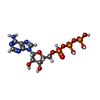 ChemComp-ATP: |
-Experimental details
-Structure determination
| Method | cryo EM |
|---|---|
 Processing Processing | single particle reconstruction |
| Aggregation state | particle |
- Sample preparation
Sample preparation
| Concentration | 5.5 mg/mL | |||||||||||||||||||||
|---|---|---|---|---|---|---|---|---|---|---|---|---|---|---|---|---|---|---|---|---|---|---|
| Buffer | pH: 7.5 Component:
| |||||||||||||||||||||
| Grid | Model: Quantifoil R1.2/1.3 / Material: GOLD / Mesh: 300 / Support film - Material: GOLD / Support film - topology: HOLEY / Support film - Film thickness: 25 / Pretreatment - Type: GLOW DISCHARGE / Pretreatment - Time: 45 sec. / Pretreatment - Atmosphere: AIR / Pretreatment - Pressure: 0.045 kPa | |||||||||||||||||||||
| Vitrification | Cryogen name: ETHANE / Chamber humidity: 100 % / Chamber temperature: 278 K / Instrument: FEI VITROBOT MARK IV / Details: 3.5 uL volume, -5 blot force, 1.5 blot time. |
- Electron microscopy
Electron microscopy
| Microscope | TFS KRIOS |
|---|---|
| Specialist optics | Energy filter - Name: TFS Selectris X / Energy filter - Slit width: 10 eV |
| Image recording | Film or detector model: TFS FALCON 4i (4k x 4k) / Number grids imaged: 1 / Number real images: 5236 / Average electron dose: 50.0 e/Å2 |
| Electron beam | Acceleration voltage: 300 kV / Electron source:  FIELD EMISSION GUN FIELD EMISSION GUN |
| Electron optics | Illumination mode: FLOOD BEAM / Imaging mode: BRIGHT FIELD / Cs: 2.7 mm / Nominal defocus max: 1.8 µm / Nominal defocus min: 0.8 µm / Nominal magnification: 130000 |
| Sample stage | Specimen holder model: FEI TITAN KRIOS AUTOGRID HOLDER / Cooling holder cryogen: NITROGEN |
| Experimental equipment |  Model: Titan Krios / Image courtesy: FEI Company |
+ Image processing
Image processing
-Atomic model buiding 1
| Initial model | Chain - Source name: AlphaFold / Chain - Initial model type: in silico model |
|---|---|
| Output model |  PDB-9nb9: |
 Movie
Movie Controller
Controller








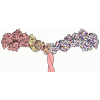
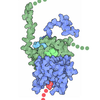

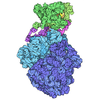
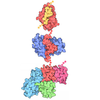
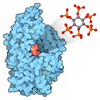
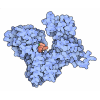
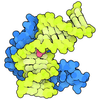





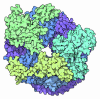
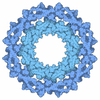

 Z (Sec.)
Z (Sec.) Y (Row.)
Y (Row.) X (Col.)
X (Col.)




















